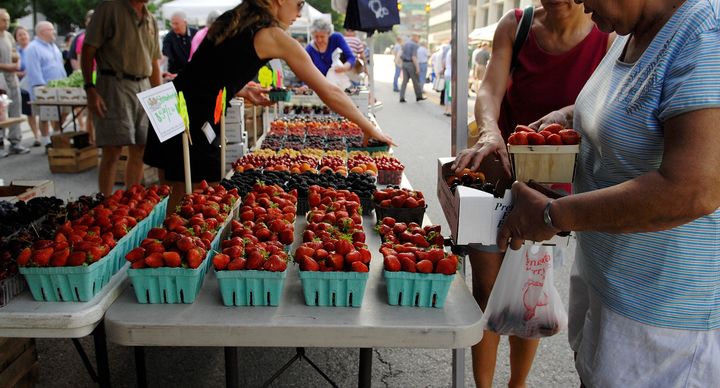
UPDATE: July 19 ― The National Association of Farmers Market Nutrition Programs, a nonprofit organization, announced Thursday that it will pay Novo Dia to continue providing technology that allows farmers market vendors to accept food stamps for an extra 30 days. That gives the U.S. Department of Agriculture’s new contractor until Aug. 30 to put a new technology in place during the busy season for farmers markets.
PREVIOUSLY:
At the end of this month, hundreds of America’s farmers markets will no longer be able to process payments from the Supplemental Nutrition Assistance Program, better known as SNAP or food stamps. The change will disproportionately affect markets in states that offer incentives to help low-income consumers buy fresh fruits and vegetables.
The reason for the service cut is not ideology, but bureaucracy. Last fall, the U.S. Department of Agriculture canceled its contract with the Farmers Market Coalition, the organization that provides farmers with the hardware and software to accept SNAP payments. Partly as a result, one of the main companies offering this technology, Novo Dia, is canceling its service and going out of business. While this outcome has been clear for months, the USDA’s new contractor has not installed a replacement technology that would allow farmers to keep accepting SNAP payments.
“There is no backup option,” said Ben Feldman, policy director for the Farmers Market Coalition. “July and August are the busiest times of the year. Farmers were promised that they would have functioning equipment and they don’t, and right now there’s no program to help them get it.”
The number of farmers markets affected by the service cut isn’t entirely clear. Novo Dia provides software and equipment for roughly 40 percent of SNAP transactions at farmers markets. Some of those markets use other technology providers as well and would likely not be affected.
But other markets are facing a significant impact. In Massachusetts, for example, the vast majority of farmers markets rely on Novo Dia’s software to process a total of $3.7 million in SNAP payments every year. The software also allows the state to administer a program that gives refunds to families who spend their SNAP benefits on fruits and vegetables.
Josh Wiles, Novo Dia’s founder and president, said that his company specialized in custom services for these incentive programs and that the states and cities providing them will be hit hardest.
“This didn’t have to happen,” Wiles said, “and the greatest impact is going to be on people who rely on farmers markets the most.”
The USDA began providing farmers markets with the equipment to process SNAP benefits in 2012. At first, this posed some logistical and technical challenges ― for example, SNAP recipients have to type in a PIN for each transaction and retailers are required to provide printed receipts ― so the USDA hired an initial contractor to make the technology easier to use.
The Farmers Market Coalition, a nonprofit that helps farmers sell to consumers, won a contract to administer the program in 2015. Novo Dia was one of the companies the coalition hired to distribute tablets, card readers and software to farmers. The technology differs from market to market: Some farmers swipe SNAP benefit cards directly on their phones or iPads, while other markets have central kiosks where shoppers can trade in their benefits for tokens. Novo Dia offered versions of its software for those models, plus customized versions designed for particular state and city regulations and incentive programs.
The current crisis began last fall when the Farmers Market Coalition’s contract ended. Feldman said the coalition submitted a bid to renew its contract. Wiles said he expected that Novo Dia would continue to provide technology to farmers markets even if the USDA chose a new contractor.
In April of this year, the USDA announced that it was turning the program over a new contractor, Financial Transaction Management. Wiles then waited for a call about renewing his contract or handing over to a new supplier. But he said the call never came. Meanwhile, since the USDA was no longer buying equipment or software licenses, Novo Dia’s revenue from farmers markets fell to nearly zero. This, combined with other contracts that didn’t come through, meant Novo Dia simply wasn’t viable anymore, Wiles said. He told his customers that he would be ceasing operations at the end of July.
As for why the USDA chose Financial Transaction Management to handle the contract, a spokesperson said only that the company was selected “through a process that met the standards of federal contracting law.” It was “both technically acceptable and the best value to the government.”
But according to publicly available documents, Financial Transaction Management was established in 2017, just a few months before winning the $1.3 million contract. It does not appear to have any experience administering government benefits, had no revenue before submitting its bid and had just one employee. The Virginia address listed in its paperwork is the same as that of a “virtual office” service.
The USDA would not make anyone available to discuss why Financial Transaction Management won the bidding process, citing concerns about proprietary information. In an email, Financial Transaction Management’s CEO, Angela Sparrow, said the company indeed started small but is expanding to meet the obligations of its contract. Sparrow said the company has offices in Washington, D.C., and the Midwest, but “the legal registered address is for our protection.”
Novo Dia’s software is currently slated to stop working on July 31, though Wiles said he is working to extend that deadline. Sparrow said a new app for farmers to take food stamps “is set to go live on July 14th” ― that is, Saturday ― but on July 13, a USDA spokesperson could not confirm that the new technology would be ready to use the following day.
This uncertainty has left states scrambling. A spokesperson from the Massachusetts Department of Transitional Assistance said the agency is working with the USDA to find a solution. This may mean swapping in another company’s technology or coming up with a state-specific workaround.
On Thursday, New York Gov. Andrew Cuomo published an open letter to the USDA saying the service cut threatened $3.4 million in SNAP spending at farmers markets.
What is clear, though, is that any interruption would be a significant inconvenience for low-income Americans who rely on farmers markets to obtain healthy food. More than $24 million in SNAP benefits were spent at farmers markets last year. Incentive programs have proliferated almost as quickly as farmers markets themselves over the last decade, and studies have shown that low-income households buy more fruits and vegetables when government programs make them more available and, especially, less costly.
According to USDA data, more than 80 percent of America’s 8,600 farmers markets accept SNAP payments. With any luck, it will stay that way.
